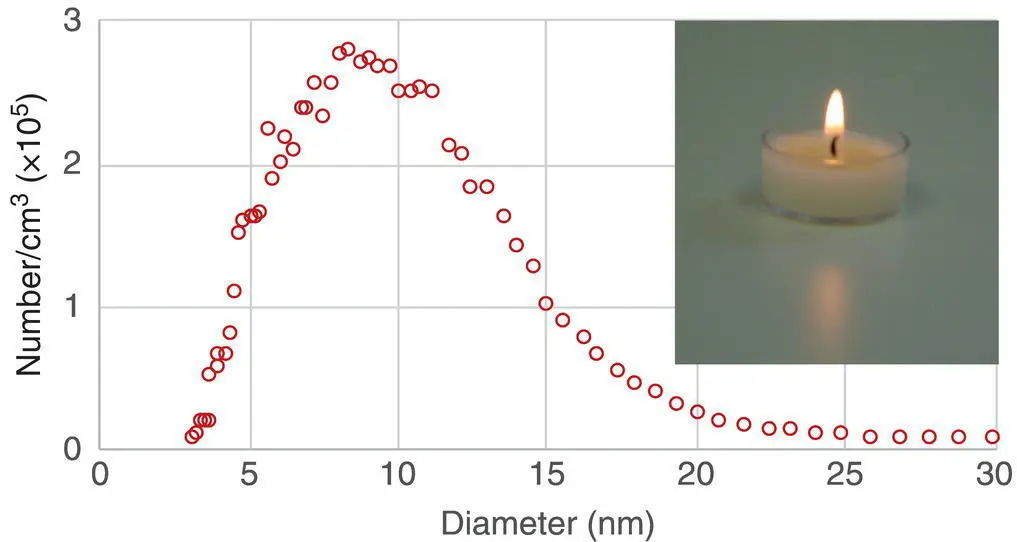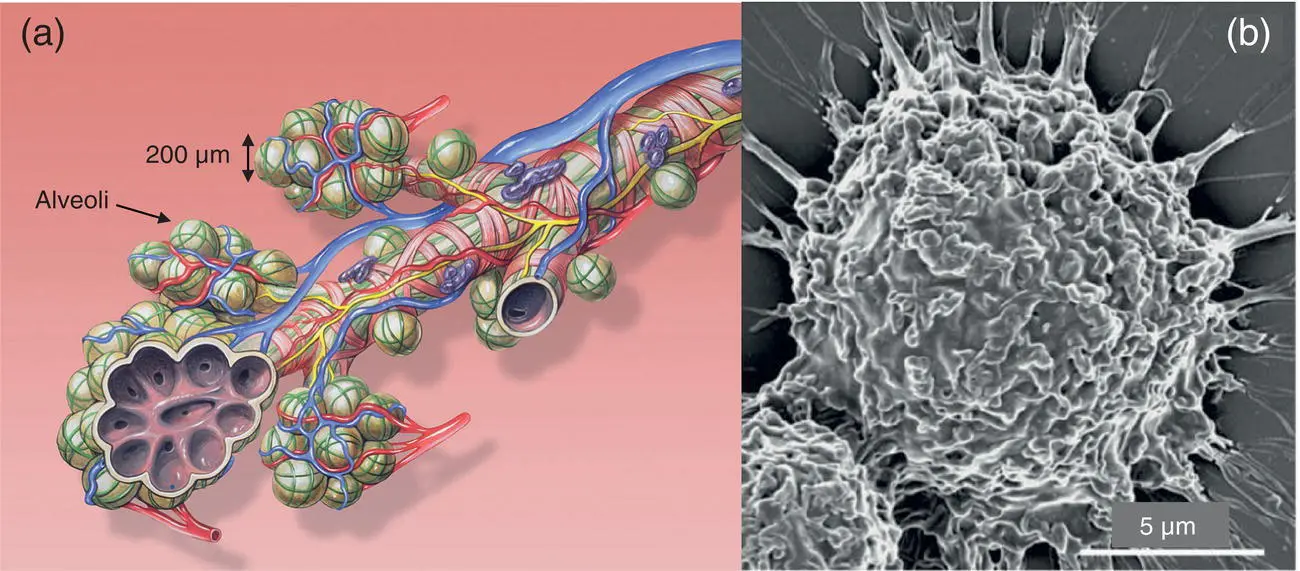
Figure 2.3 Nanoparticles produced by candles.The size distribution of particles produced by combustion from a standard “nightlite” type candle. The distribution was measured using an aerosol particle sizer and if plotted as the number density, consists mostly of nanoparticles with diameters around 10 nm. These are predominantly carbon particles. The method used to measure the size distribution (differential mobility analyzer) is described in Chapter 5, Section 5.1.7.
2.2 Atmospheric Nanoparticles and Health
The effect on the body of exposure to nanoparticles is a hot topic in the debate on the benefits/hazards of nanotechnology, but there is limited hard information to inform the discussion. It is worth emphasizing that life on this planet evolved in a dense cloud of naturally occurring nanoparticles and we have been exposed to nanoparticles produced by human activity since the invention of fire. In addition, industrial activity based on certain types of nanoparticles, for example, carbon black, has been around since early civilizations. The difference now is that new nanotechnology industries will produce nanoparticles composed of a wide range of different materials as well as other forms of “nanomaterial” such as carbon nanotubes (see Chapter 3). Whichever way the nanoparticles enter the body, there is a highly developed immune response to clear them in the same way that any foreign invaders, including bacteria and viruses are removed. The clearance mechanisms are described in Chapter 8, Section 8.1.2, but the end result is that nanoparticles are passed out of the body via the feces or the urine. As we will see in Chapter 8, which describes medical applications of nanoparticles, keeping them in circulation for long enough to carry out their therapeutic or diagnostic function can be a problem. Here, the potential health risks of accidentally ingested nanoparticles will be discussed. There are three general surfaces in the body that act as interfaces, that is, the lungs, intestines, and skin and each will be considered.
2.2.1 Entry Via the Lungs
The lungs have to deal with the biggest nanoparticle load as they are designed to exchange material directly with the environment. Within the lungs, a system of finer and finer tubes terminates at clusters of tiny air sacs called alveoli ( Figure 2.4a), typically 200 μm (0.2 mm) across. There is a capacity for a huge number of these and an adult lung contains of the order of 500 million alveoli thus presenting an area of about 100 m 2in adults (about half a tennis court) to the environment. The alveoli are encased in blood vessels and the barrier separating the flowing blood and air in the alveoli is about 300 nm, which is thin enough to allow gas molecules to diffuse through. Particles that enter the lungs, if they are smaller than a few microns can pass right through the tubular system and into the alveoli. Nanoparticles, with diameters less than 100 nm almost all end up in the alveoli.

Figure 2.4 Nanoparticles and the lungs.(a) Anatomy of finest bronchial tubes terminating in clusters of tiny sacs (alveoli) 0.2 mm across and wrapped in blood vessels. The adult lung contains about 500 million of these with a total surface area of about 100 m 2. Across a significant proportion of this surface, the tissue separating air and blood is as thin as 300 nm and allows gas molecules to diffuse across.
Source : Patrick J. Lynch https://commons.wikimedia.org/wiki/File:Bronchial_anatomy.jpg. Licensed under CC BY 2.5.
(b) Alveolar macrophages, typically 10 μm across that occupy the lungs and the alveoli. They ingest particles by phagocytosis and are carried up through the lung system by a slow mucus flow called the mucociliary escalator. They are eventually swallowed and pass out through the digestive system.
Source : Reproduced with permission from [4].
Since humans have evolved in the presence of atmospheric aerosols, the body has well‐developed mechanisms to cope with inhaled particles including nanoparticles. Dispersed throughout the airways of the lung right down to the alveoli are specialized cells with typical sizes of around 10 μm known as macrophages ( Figure 2.4b). These are able to ingest particles using a mechanism (phagocytosis) in which the cell wall of the macrophage envelops the foreign body and passes it through to the interior. The cells are passed, with their cargo of absorbed particles, to the top of the lungs by a gradual upward drift of mucus, called the mucociliary escalator , so they can be swallowed and passed out through the digestive system. It typically takes the escalator about 70 days to clear a particle from the deepest part of the lungs through this time increase if the number of particles starts to overwhelm the macrophages. Particles deposited near the top of the airway can also adhere directly to the mucus and be removed by the mucociliary escalator.
The system copes admirably with the huge number of particles that we constantly breathe in, which can be estimated to be about 15 million per breath and, according to Figure 2.2, made up almost exclusively of nanoparticles with diameters smaller than 100 nm. There are, however, several fundamental mechanisms by which over‐exposure to nanoparticles can adversely affect health, the first one being their tendency to overwhelm the clearance process. It has been known for some time that phagocytosis works best for particles with sizes around 1 μm but becomes inefficient for particle sizes below 100 nm [5]. More recent studies have shown that the clearance time for nanoparticles of titanium dioxide with a diameter of 20 nm is significantly longer than particles with a diameter of 200 nm [6]. In addition, titanium dioxide in the form of nanoparticles results in a greater incidence of tumors than larger particles. Other studies have shown that preexposure of macrophages to titanium dioxide or carbon nanoparticles limits their ability to subsequently ingest larger particles by phagocytosis [7]. Thus, nanoparticles are cleared slowly but in addition, they can slow down the clearance of all particles, including those that are micron‐sized, so their over‐abundance can lead to chronic exposure and increased risk of tumors forming.
Inhaled nanoparticles can also affect parts of the body away from the lungs and cardiovascular disease is one well‐known consequence of their inhalation [8]. One hypothesis for the cause is that the particles produce inflammation within the lungs that results in the systemic release of cytokines. These are small proteins involved in cell signaling and regulation of the immune system and their release can have adverse side effects on the cardiovascular system. Another important mechanism that allows nanoparticles, especially those near the bottom end of the size scale (5–10 nm), to have a systemic effect is that they are able to translocate. That is, they pass through the alveoli into the blood circulation and are then deposited around the body.
Recently, the first systematic study of the translocation of nanoparticles in humans [9] was carried out using gold (Au) nanoparticles produced in an aerosol by a spark source (see Chapter 5, Section 5.1.6). During moderate exercise, fourteen male volunteers breathed in the aerosol consisting of 18.7 nm diameter Au nanoparticles at a density of 6 × 10 6/cm 3. This is about 10 times the number density of all nanoparticles of the same size in the ambient background (see Figure 2.2). Blood and urine samples were taken over the first 24 hours and then again after three months and the amount of Au in the samples was measured using mass spectrometry. The results for the 18.7 nm diameter nanoparticles are shown in Figure 2.5a and it is evident that the nanoparticles are detectable in the blood almost immediately in some patients. After six hours Au was present in the blood samples of most (12/14) of the volunteers and was still detectable in half the patients after three months. This indicates that the nanoparticles stay in the lungs for a considerable time, which is consistent with their slow removal, as described above, and they are slowly absorbed over a long time. It should be emphasized that a rough estimate of the proportion of Au nanoparticles of this size that are translocated is 0.02% but the study clearly showed that translocation is a viable mechanism for breathed in nanoparticles to have a systemic effect.
Читать дальше














